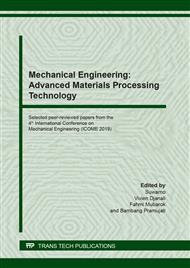p.1
p.8
p.17
p.25
p.32
p.41
p.48
p.54
The Effect of EDM Process on the Microstructure of CP-Titanium Grade 2 and AISI 316 L in Cardiovascular Stent Manufacturing
Abstract:
The aim of this research is to investigate the effect of the EDM process on the microstructure of CP-Titanium grade 2 and AISI 316 L in cardiovascular stent manufacturing. The microstructure was observed by an optical light microscope, and the microhardness test is conducted by microhardness vikers to validate the phase that is formed on the material. The pulse currents which were used in the manufacturing of stent by die sinking EDM were 1.5 A and 6.0 A. The experimental results show that the microstructure of CP-Titanium grade 2 is transformed after EDM in cardiovascular stent manufacturing, but it does not occur in the material AISI 316 L. The microstructure of CP titanium grade 2 is transformed from equiaxed α to be TiH for 1.5 A, and equiaxed α to be α’ martensite and TiH for the pulse current 6.0 A. The hardness of equiaxed α, α’ martensite, and TiH are 108 HVN, 113 HVN, and 254 HVN, respectively. The HAZ only occurs in the CP-Ti 2, and its depth for 1.5 A and 6.0 A are 45 μm and 73 μm, respectively.
Info:
Periodical:
Pages:
1-7
Citation:
Online since:
October 2020
Keywords:
Price:
Сopyright:
© 2020 Trans Tech Publications Ltd. All Rights Reserved
Share:
Citation:


